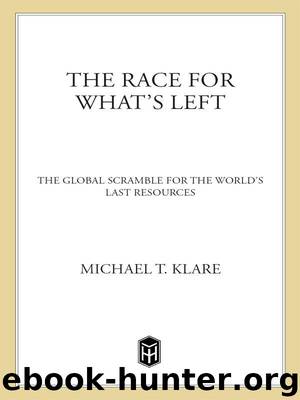The Race for What's Left: The Global Scramble for the World's Last Resources by Klare Michael T

Author:Klare, Michael T. [Klare, Michael T.]
Language: eng
Format: mobi
Publisher: Macmillan
Published: 2012-03-12T16:00:00+00:00
TABLE 6.1: THE RARE EARTHS AND THEIR USES
Sources: U.S. General Accounting Office, Rare Earth Materials in the Defense Supply Chain, April 1, 2010; Keith Bradsher, “China Tightens Grip on Rare Minerals,” New York Times, September 1, 2009.
The distinctive properties of rare earths make them especially valuable for military applications. According to a 2010 briefing prepared for Congress by the Government Accountability Office (GAO), “the use of rare earth materials is widespread in defense systems. These include, among others, precision-guided munitions, lasers, communications systems, radar systems, avionics, night vision equipment, and satellites.” Specific systems cited by the GAO included the Aegis SPY-1 radar, which contains samarium-cobalt magnet components; the M1A2 Abrams tank, which uses similar technology; and the DDG-51 destroyer, which relies on a hybrid drive system employing neodymium magnets.17 Samariumcobalt magnet motors are also used to steer many precision-guided bombs and missiles and to power the tail fins of high-performance fighter aircraft such as the F-22 Raptor.18
The fact that rare earths are vital to so many high-technology applications is one reason why the Chinese restrictions on their shipment provoked such a global panic. Even more troubling to the general public was the sudden realization that China has completely monopolized the mining, processing, and refining of these materials. David Sandalow of the DoE estimates that China now accounts for some 95 percent of total worldwide rare earths production, and other experts place the figure as high as 97 percent.19 This is not because the world’s REE reserves are located exclusively in China: several other countries, including Australia, Canada, and the United States, possess significant deposits as well, and the United States used to have its own domestic REE supply chain.20 But natural concentrations of rare earths are uncommon, and so normally they must be extracted from composite ores containing many other minerals—including, in many cases, radioactive materials—through a costly and hazardous process.21 The procedure usually involves using acids of various kinds to leach rare earths from the surrounding stone, producing toxic wastes that can poison farms and water supplies unless they are carefully disposed of. By overlooking the environmental risks and lowering its production costs, China was able to undercut the other REE suppliers, eventually leading nearly all of its competitors to suspend their operations (see Table 6.2).22
Download
This site does not store any files on its server. We only index and link to content provided by other sites. Please contact the content providers to delete copyright contents if any and email us, we'll remove relevant links or contents immediately.
| Acoustics | Bridges |
| Earthwork Design | Environmental |
| Fire Science | Highway & Traffic |
| Hydrology | Remote Sensing |
| Seismic Design | Structural |
| Structural Dynamics | Surveying & Photogrammetry |
| Transportation |
Whiskies Galore by Ian Buxton(41867)
Introduction to Aircraft Design (Cambridge Aerospace Series) by John P. Fielding(33064)
Small Unmanned Fixed-wing Aircraft Design by Andrew J. Keane Andras Sobester James P. Scanlan & András Sóbester & James P. Scanlan(32743)
Craft Beer for the Homebrewer by Michael Agnew(18140)
Turbulence by E. J. Noyes(7935)
The Complete Stick Figure Physics Tutorials by Allen Sarah(7307)
Kaplan MCAT General Chemistry Review by Kaplan(6866)
The Thirst by Nesbo Jo(6826)
Bad Blood by John Carreyrou(6543)
Modelling of Convective Heat and Mass Transfer in Rotating Flows by Igor V. Shevchuk(6391)
Learning SQL by Alan Beaulieu(6208)
Weapons of Math Destruction by Cathy O'Neil(6140)
Man-made Catastrophes and Risk Information Concealment by Dmitry Chernov & Didier Sornette(5921)
Digital Minimalism by Cal Newport;(5661)
Life 3.0: Being Human in the Age of Artificial Intelligence by Tegmark Max(5474)
iGen by Jean M. Twenge(5366)
Secrets of Antigravity Propulsion: Tesla, UFOs, and Classified Aerospace Technology by Ph.D. Paul A. Laviolette(5309)
Design of Trajectory Optimization Approach for Space Maneuver Vehicle Skip Entry Problems by Runqi Chai & Al Savvaris & Antonios Tsourdos & Senchun Chai(5011)
Electronic Devices & Circuits by Jacob Millman & Christos C. Halkias(4907)
